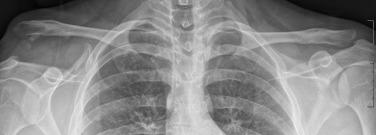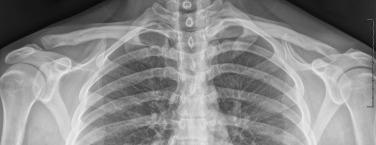Physical Address
304 North Cardinal St.
Dorchester Center, MA 02124
Acromioclavicular (AC) joint and associated coracoclavicular (CC) ligament injuries frequently occur in active individuals when they fall directly onto their shoulder in an adducted position. The Rockwood classification is the most commonly used system for categorizing AC injuries, and helps to determine appropriate treatment. Nonoperative management of grade I and II injuries with a brief period of immobilization followed by a progressive return to activities is often successful, whereas grade IV, V ( Fig. 35.1 ), and VI ( Fig. 35.2 ) injuries are most effectively managed with surgical treatment. The initial treatment of grade III ( Fig. 35.3 ) injuries is more controversial, with some patients being able to return to their normal activities without surgery, whereas surgical reconstruction may provide more favorable outcomes for those wishing to return to occupations or sports with frequent overhead arm position or other high functional demands of the shoulder. However, surgical reconstruction has not consistently improved anatomical reduction, and a recent review of the literature reported a 11% reoperation rate within the first 6 months. Therefore, in contemplating surgical reconstruction, the surgeon and patient should discuss these factors and feel equipped to encounter an imperfect result.



Complications in the reconstruction of the AC joint are as diverse as the array of surgical techniques described to address AC joint instability. Because of the subcutaneous location of the distal clavicle and AC joint, surgery in this area is especially prone to complications such as skin healing issues, hardware prominence, and infection. Loss of reduction and/or continued instability, iatrogenic fracture, implant loosening, graft failure, erosion of suture or bone, osteolysis around implanted hardware, and stiffness are common enough complications that surgeons should be well aware of these issues and pursue strategies to avoid these pitfalls. The risk of iatrogenic injury to nearby neurovascular structures and the lung and complications related to autograft harvest at sites remote to the AC joint should also be in the forefront of the surgeon’s mind. This goal of this chapter is to elucidate what is known about these complications, offer tips on how to avoid them, and provide guidance on managing them when they do occur.
The clavicle is relatively flat in the coronal plate but S-shaped in the body’s axial plane, with the conoid tubercle prominent on the posterior aspect of the clavicle near its lateral end. The clavicle functions as both a strut from the axial skeleton to the scapula and a site for muscular attachment to control the shoulder.
The AC joint is a diarthrodial joint, incompletely divided by a disk with central perforations, that is the only articulation between the clavicle and scapula. The AC joint’s anteroposterior (AP) stability is primarily provided by the AC joint capsular ligaments that are thicker on the superior, anterior, and posterior surfaces, whereas the CC ligaments are the primary stabilizers in the vertical plane. The thickest and most consistent portion of the AC capsular ligament runs obliquely from the anterior acromion over the superior joint surface to the posterior distal clavicle at a 30-degree angle. The native anatomy allows approximately 8 mm of anterior translation, 9 mm of posterior translation, and 20 degrees of rotation through the AC joint. In about 40% of intact AC joints, the anterior and posterior borders of the distal clavicle and articulating acromion do not line up, with overhang possible on either side.
The CC ligaments, consisting of the more anterolateral trapezoid ligament and more posteromedial conoid ligament, both originate near the base of the coracoid, 28 mm and 22 mm posteriorly to its tip in males and females, respectively. They insert on the inferior surface of the distal clavicle, with the centers of the trapezoid and conoid ligament approximately 25 mm and 40 mm medial to the lateral edge of the clavicle and AC joint, respectively. ,
Become a Clinical Tree membership for Full access and enjoy Unlimited articles
If you are a member. Log in here